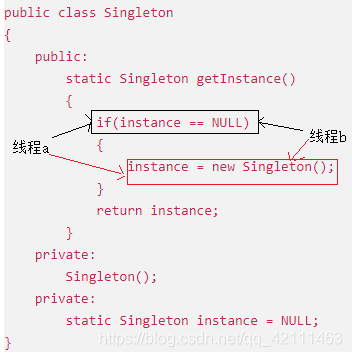单例模式简单来说就是一个类只能创建一个对象的设计模式。
设计步骤:
1.生成对象的接口必须屏蔽起来,包括构造函数以及拷贝构造函数。
2.生成唯一一个对象的接口,返回值为类*或者类&(保证了不会产生临时对象)
3.摆脱构造函数对对象的依赖,设置为静态的。
4.对象存放在堆上。(静态方法访问静态成员变量)
(1)想让一个类只能构建一个对象,则Signleton的构造方法只能为私有的。
(2)instance是Signleton类的静态成员,也是单例对象。
(3)getInstance是获取单例对象的方法。
//单例模式的代码实现,此时只适合于在单线程中使用
public class Singleton
{
public:
static Singleton getInstance()
{
if(instance == NULL)
{
instance = new Singleton();
}
return instance;
}
private:
Singleton();
private:
static Singleton instance = NULL;
}
分析上述代码:
如果Singleton类刚被初始化,instance对象还为空这时候如果同时去访问getInstance,因为instance是空的,所以两个线程同时通过了条件判断,开始执行new操作。

要想实现一个线程安全的单例模式:
(1)为了防止 new Singleton()执行多次,则需要在new之前加上锁。需要加上一个同步锁。
(2)进入临界区应再做一次判空,当两个线程同时访问的时候,线程a构建完成对象,线程b也已经通过了最初的判空验证,如果不做第二次判空,线程b将会依旧去创建新对象。
//================剑指offer面试题一==============
//题目:设计一个类,只能生成这个类的一个实例
# include <iostream>
class Singleton
{
public:
static Singleton getInstance()
{
if(instance == NULL)
{
lock(syncObj);
{
if(instance == NULL)
{
instance = new Singleton();
}
}
return instance;
}
private:
Singleton();
private:
static Singleton instance = NULL;
}

利用静态内部类实现单例模式
利用外部无法访问静态内部类,只有当调用Singleton .getInstance时才可以得到单例对象。
public class Singleton
{
public static class Nested{
public static Singleton getInstance()
{
return Nested.instance;
}
private:
Singleton(){};
private static final Siglenton instance;
}
}